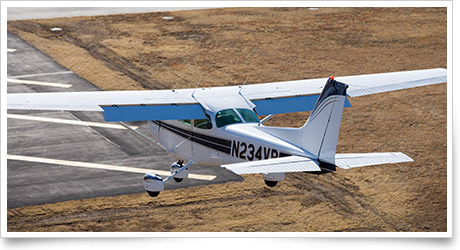| The following stories from the Feb. 17, 2012, edition of AOPA ePilot were provided to AOPA members who expressed an interest in the particular subject areas. Any AOPA member can receive information tailored to their areas of interest by updating their preferences online |
training tipsNo time to improvise What if your corrections just don't get the job done? As you roll out of your base leg you realize that you have drifted well downwind of the extended runway centerline. There you are, descending at approach airspeed, either partially or fully configured for landing, at low altitude. Can the approach be saved? Here's a better question: Should the approach be saved? It may be of some comfort to learn that every pilot overshoots a final turn or two while learning how to recognize and avoid the conditions that cause the problem. And by an overshoot let's define the term as something of greater concern than a slightly inaccurate turn to final that requires only minor adjustments with shallow bank angles. For many new pilots, a full-blown overshoot—one readily noticeable from the ramp or the tower, for instance—is one of the first situations that pits their judgment about safe flying against the equally powerful urge to "save" the landing attempt. Set pride aside. Go around! There's no need to court trouble down low with excessive (and almost certainly uncoordinated) maneuvering. Remember that even if you succeed in scuttling back to the extended centerline, you must still realign the aircraft's longitudinal axis for landing. Meanwhile, what's happening to your vertical profile? The distractions have likely left your aircraft too high from failure to readjust power, or too low as a result of excessive maneuvering. Either way, your formerly stabilized approach is history. At a tower-controlled airport, don't shrink from informing the controller of your need to abandon the approach. He or she may already have spotted the problem, and will calmly issue new instructions—perhaps an upwind traffic-pattern re-entry. At a nontowered airport, first focus on flying the airplane, and then make your announcement on the common traffic advisory frequency. Quick quiz: Can you recite your trainer's balked-landing procedure from memory, right now? Chair-flying a go-around or two before supper tonight may pay dividends in the traffic pattern if the need ever arises. training products‘Flying the Tail Wheel Airplane’Learning to fly in a conventional-gear airplane, or interested in making the switch? A new book, Flying the Tail Wheel Airplane by Jim Alsip, offers step-by-step instructions that gradually build in complexity as the book progresses. Photographs from the cockpit illustrate key points and principles and serve to emphasize stick-and-rudder skills from the pilot's perspective. Alsip is a Master CFI and charter member of the Society of Aviation and Flight Educators and provides tailwheel and aerobatic instruction in a Super Decathlon. The book is available on Amazon.com.
Note: Products listed have not been evaluated by ePilot editors unless otherwise noted. AOPA assumes no responsibility for products or services listed or for claims or actions by manufacturers or vendors. final exam
Question: As a student pilot, once I solo, am I automatically allowed to make cross-country flights?
Answer: No. Your flight instructor must first determine that you are qualified and ready to conduct a cross-country flight. Once the instructor is satisfied you are competent to do so, he or she will endorse your student pilot certificate. An initial solo cross-country flight endorsement is also required to be entered in your logbook. Prior to the cross-country flight, an instructor must have reviewed your preflight planning and preparation for the solo flight and determined that the flight can be made safely under the known circumstances and conditions. The instructor must endorse your logbook prior to each cross-country flight, stating that you are considered competent to make the flight. Under certain conditions, an instructor may also authorize repeated solo flights over a given route. For more on endorsements see Advisory Circular 61-65E.
Got a question for our technical services staff? E-mail [email protected] or call the Pilot Information Center, 800/872-2672. Don’t forget the online archive of “Final Exam” questions and answers, searchable by keyword or topic. |
 The Feb. 10
The Feb. 10 

